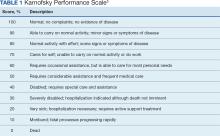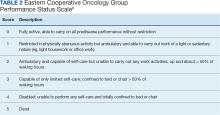Prognostication in Hospice Care: Challenges, Opportunities, and the Importance of Functional Status
Background: Predicting life expectancy and providing an end-of-life diagnosis in hospice is very challenging for most clinicians given their generally poor training for this role and limited medical education. End-of-life diagnosis alone is often used to certify hospice appropriateness. It is essential, however, to document good supporting evidence of decline and comorbidities. Functional status can be a helpful criterion prior to hospice admission and during required 90-day certifications.
Case Presentation: An 80-year-old male who was diagnosed with Stage IV glioblastoma multiforme was transferred from an acute care hospital to a community living center hospice service for end-of-life care. After 6 months of care, the veteran was able to graduate from hospice and transfer to an adult living facility with minimal care needs.
Conclusions: Recognizing the importance of documenting and using functional scales in individuals receiving hospice care is extremely helpful in prognostication.
Predicting life expectancy and providing an end-of-life diagnosis in hospice and palliative care is a challenge for most clinicians. Lack of training, limited communication skills, and relationships with patients are all contributing factors. These skills can improve with the use of functional scoring tools in conjunction with the patient’s comorbidities and physical/psychological symptoms. The Palliative Performance Scale (PPS), Karnofsky Performance Scale (KPS), and Eastern Cooperative Oncology Group Performance Status Scale (ECOG) are commonly used functional scoring tools.
The PPS measures 5 functional dimensions including ambulation, activity level, ability to administer self-care, oral intake, and level of consciousness.1 It has been shown to be valid for a broad range of palliative care patients, including those with advanced cancer or life-threatening noncancer diagnoses in hospitals or hospice care.2 The scale, measured in 10% increments, runs from 100% (completely functional) to 0% (dead). A PPS ≤ 70% helps meet hospice eligibility criteria.
The KPS evaluates functional impairment and helps with prognostication. Developed in 1948, it evaluates a patient’s functional ability to tolerate chemotherapy, specifically in lung cancer, and has since been validated to predict mortality across older adults and in chronic disease populations.3,4 The KPS is also measured in 10% increments ranging from 100% (completely functional without assistance) to 0% (dead). A KPS ≤ 70% assists with hospice eligibility criteria (Table 1).5
Developed in 1974, the ECOG has been identified as one of the most important functional status tools in adult cancer care.6 It describes a cancer patient’s functional ability, evaluating their ability to care for oneself and participate in daily activities.7 The ECOG is a 6-point scale; patients can receive scores ranging from 0 (fully active) to 5 (dead). An ECOG score of 4 (sometimes 3) is generally supportive of meeting hospice eligibility (Table 2).6








